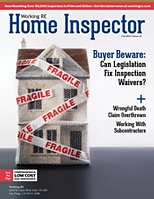 | > E&O/GL Insurance for Home Inspectors Competitive Rates, Broad Coverage, Free Risk Management, online inspection support for tough questions, discounts on education and more… Professional Coverage, Competitive Pricing Shop OREP today! |
Avoiding a Conundrum When Including an Addendum
by Greg Nelms, Nelms Inspections
Technically speaking, an addendum is additional material added to the end of a document, typically to correct, clarify or supplement something that precedes it. The word “addendum,” or the plural “addenda,” is derived from the Latin addere, which means “must be added.” While an addendum to a home inspection report is perfectly fine and somewhat common, it must be done correctly.
Additions to an inspection report are sometimes necessary due to reinspecting a system or area that could not be evaluated during the original home inspection. Sometimes, an inspector simply forgets to include something that should have been in the report or wants to clarify a statement to make it more easily understood. Whatever the case, it is important to understand this is additional information and amends the original inspection report.
However, when receiving a call from a client about something that wasn’t included in the inspection report, some home inspectors actually alter their original report and resend this “new” and “changed” version to the client, with the additional items that were in question. This is wrong on many levels and can land the home inspector in unexpected trouble.
Liability of Two Reports
The issue with this approach is the home inspector and client now have two separate reports, with different findings concerning the identical property and date for the same customer. This could be particularly problematic if a complaint from the client arises. For starters, your insurance claims department or state governing body will request a copy of the inspection report from you and the client. The client may send the “original” inspection report, while you submit the “new and corrected” version.
This will raise many red flags and questions for your insurance company, including:
- Did the inspector make a new report to hide the fact that he/she missed something important?
- Are there different versions of the report?
- Was the inspector incompetent or negligent?
- Which report will be used to prosecute or defend the claim?
The reason two inspection reports were created matters less than the fact both exist. Your insurance company now has to defend against a possible claim, including arguing that you, as the insured, were not trying to cover up a mistake with a “changed” report, which is very difficult. In addition, if your state has a governing body that oversees home inspectors, it will have serious questions you’ll have to answer.
(story continues below)
(story continues)
The Right Approach
While an addendum should be its own document and its purpose is to update or augment the initial report, it should follow the same format as the original as much as possible. By using the same language, font and style, no parties should have any doubt that the addendum is as important and relevant as the first report that was issued.
The addendum must make it clear what changes it makes to the original inspection report. This can be accomplished by choosing a title, such as “Electrical” or “Plumbing,” which clarifies what part of the initial report the addendum refers to. The new document should also have the property address, client name, inspection report number, date the addendum was drafted, and the new date for the reinspection if one was conducted. This all helps define the parties involved and the inspected property.
It is also important to refer back to the original home inspection report when drafting the addendum. For example, you can insert phrases like: “as stated in the original report,” “since the system was obstructed and could not be inspected or described within the original report,” etc. This helps tie the report and addendum together as one complete report.
If the reason for the addendum was to reinspect something that was inaccessible or inoperable during the initial home inspection, make it clear that only the system or component that could not be inspected is evaluated and described within the addendum report. Including this statement eliminates any misconception that other systems or observed defects from the original home inspection are also re-evaluated.
A “scope of inspection,” which defines what is going to be inspected and any limitations to the inspection should be in every inspection report and any follow-up addendum. All too often, the client has misperceptions of what is actually inspected, and the “scope of inspection” comments remove questions on what could and could not be accomplished during the inspection.
Protect Yourself
Critically, the original home inspection report and addendum must not be construed as separate reports but two documents that must be viewed together to comprise a completed, singular inspection report.
The bottom line for home inspectors is to never change your initial report. However, it is an acceptable practice to issue an addendum to the original as long as you make it clear that it is additional information to clarify a condition or include supplementary information.
About the Author
Greg Nelms is the author of this article. Mr. Nelms is the owner of Nelms Inspections and has been a home inspector for 35 years. Mr. Nelms is also an instructor for the home inspection courses required by the State of New Jersey to obtain a home inspection license. He is a guest educational speaker for seminars across the country and often is asked to specifically teach on the subject of report writing. He can be reached at nelmsinspections@gmail.com.

OREP Insurance Services, LLC. Calif. License #0K99465


